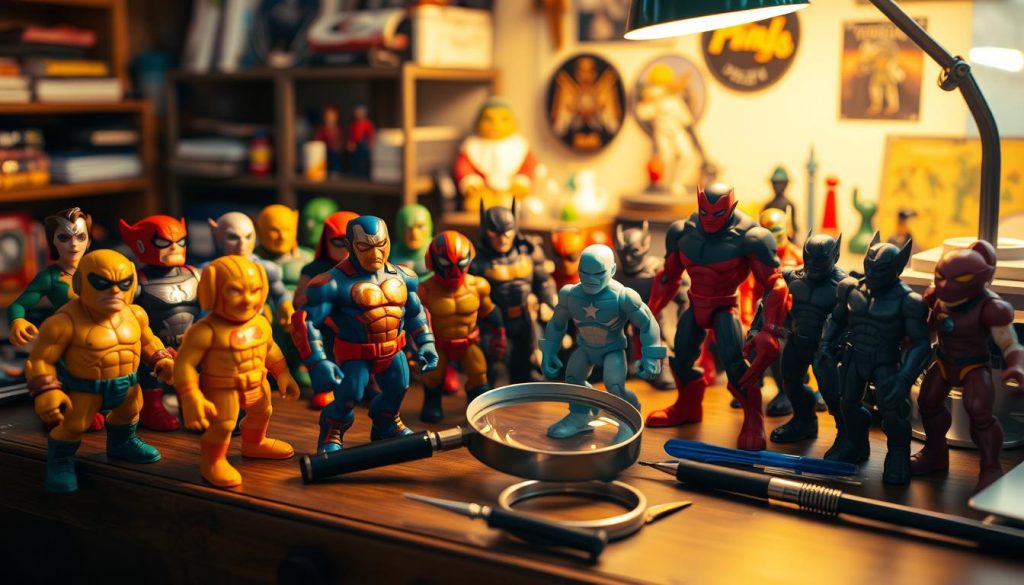The collectible toy world is thrilling but has counterfeit risks. The market has seen more fake toys due to high demand from collectors. For toy lovers, knowing the signs of fake toys is key. This guide gives you important tips on spotting counterfeit toys. It helps protect your collection and investment.
Fake toys often look very similar to real ones, which makes telling them apart hard. With the right knowledge, you can spot the difference. This guide will show you how to recognize fake toys. It aims to prevent the disappointment and money loss from buying counterfeits.
Knowing how to spot fakes helps protect the value of your collection. It also supports the creators of real, high-quality toys. You will learn how to check packaging, labels, and craftsmanship. This guide provides the tools needed to be a careful collector in the toy market.
Key Takeaways
- Learn why spotting fake toys is essential to safeguarding your collection.
- Understand the common tactics used by counterfeiters.
- Gain insights into examining packaging, labeling, and craftsmanship.
- Discover the importance of researching toy values and rarity.
- Find out how to utilize expert opinions and collector groups effectively.
Understanding Fake Toys: Definition and Impact
The collectible toy world is big and complex. For collectors, knowing real from fake is key. A detailed fake toys identification guide helps protect collections and supports real businesses.
What Constitutes a Fake Toy?
A fake toy is a counterfeit designed to trick buyers. It’s different from knock-offs or unofficial items, as it tries to seem real. Spotting a fake needs close attention to things like material and logos, crucial for fake toys recognition strategies.
The Rise of Counterfeit Collectibles
In the last decade, fake collectibles have become more common. Their demand has made a big market for fakes. This issue affects legal rights and hits real makers hard financially. With a good fake toys identification guide, collectors can find their way through this tricky area.
Why It Matters for Collectors
Knowing how to spot fakes is vital for collectors. Buying fakes lowers the value of their collections and supports crime. Using solid fake toys recognition strategies keeps collections pure and helps the market. Smart collectors help keep the hobby’s value high, supporting real makers.
| Aspect | Authentic Toys | Fake Toys |
|---|---|---|
| Material Quality | Top-notch, lasting materials | Low-quality, often unsafe materials |
| Brand Markings | Correct logos, trademarks | Wrong, misspelled logos |
| Packaging | Sturdy, well-made packaging | Weak, misleading packaging |
“Understanding the difference between real and fake toys isn’t just for keeping a collection; it’s for keeping the whole collectible market honest.” — National Collectors Association
Identifying Common Types of Fake Toys
The toy collecting market is growing fast. It’s become very important to tell authentic toys from fake ones. By understanding how to spot the differences, collectors can protect their investments. They can also enjoy the real value of their collections.
Replicas vs. Originals
Knowing the difference between replicas and originals is the first step. Replicas look like the original but they’re not made as well. Focus on paint finish, mold precision, and how the toy feels.
- Paint finish and detailing
- Mold precision
- Weight and material feel
Popular Brands Frequently Counterfeited
Some brands are copied more because they’re popular and valuable. Be careful when buying toys from:
- LEGO
- Funko Pop!
- Hot Wheels
- Transformers
Knowing what the real toys from these brands look like helps in spotting fakes.
Materials and Construction Quality
The quality of materials and construction is key in spotting fake toys. Real toys use better materials and are well-made. Look for:
| Aspect | Original | Fake |
|---|---|---|
| Material | Durable and premium plastic/metal | Flimsy and low-grade plastic/metal |
| Weight | Proportionate to size | Often too light or too heavy |
| Seams | Consistently smooth and clean | Rough with visible gaps |
Inspecting these factors closely helps in telling real toys from fakes.
Labeling and Packaging: Key Red Flags
Learning to check the labels and packaging of collectible toys is crucial for identifying fakes. By paying attention to a few details, you can often tell real from fake toys. Here are some tips on what to look for in labels, packaging, and included items like manuals and accessories.
Analyzing Manufacturer Labels
To spot fake toys, start with the manufacturer labels. Authentic toys have clear, correct, and standard labels. Look for these things:
- Proper spelling and grammar
- Consistent font sizes and styles
- Correct placement and alignment
Blurry labels, or those with wrong spelling, suggest the toy might be a fake.
Packaging Quality and Authenticity
The packaging’s quality is a big hint too. Real toys come in strong, well-made boxes. Here’s what to check:
- Sturdy material and professional printing
- Sealed packages without any signs of tampering
- Properly aligned logos and artwork
Signs like poor materials, faded colors, or misaligned prints may mean the item is counterfeit.
Instruction Manuals and Accessories
Real toys usually include detailed manuals and quality accessories, which fakes often lack. Check the following:
- Thoroughly detailed and professionally printed manuals
- Accessories that match the advertised image in quality and color
- Presence of manufacturer contact information
If the manuals are missing or the accessories look cheap, those are signs it might be fake.
Use these tips to avoid fake collectible toys. Be careful and inspect labels, packaging, and materials carefully to confirm your toys are authentic.
Examining Craftsmanship and Details
When you want to spot fake toys, it’s key to check their quality and small features closely. Learning to look closely at the paint, joints, and marks can help a lot in inspecting collectible authenticity.
Inspecting Paint Job and Finishing
A toy’s paint quality can show if it’s real or not. True collectibles have perfect paint without messes or uneven areas. Fake toys often have blotches, smudges, or paint that’s not applied right. Look closely at the toy’s face, hands, and other detailed parts for clean work.
Assessing Joints and Articulation
How a toy’s joints are made is also important. Real toys have smooth joints that move well. Fake ones might have joints that are too loose or too tight, showing bad making. Checking these parts can help make sure you’re not tricked by a fake.
Looking for Serial Numbers and Marks
Serial numbers and marks from the maker are key to tell if a toy is legit. These details are usually hidden, maybe on the toy’s foot, back, or inside. When looking, make sure these marks match what’s known for the brand. Comparing them with official records can help a lot in inspecting collectible authenticity.
Using these checks can help you get better at recognizing counterfeit toys and choosing your collectibles wisely.

Researching Toy Values and Rarity
It’s key for collectors to know the value and rarity of toys to steer clear of fakes. By using trusted sources and community know-how, telling real items from counterfeits becomes easier.
Knowing the Market: Price Guides
Price guides are a collector’s best friend. They list current prices and market trends. Guides like Beckett or ToyPrice give insights into different toy lines. This helps spot fake toys.
Identifying Limited Editions vs. Mass-Produced Items
Limited edition toys are usually more valuable than mass-produced ones. Knowing their special features and how many exist helps prove they’re real. Looking into official releases and what manufacturers say is key.
Utilizing Online Collector Communities
Online collector communities are full of valuable insights. Joining forums and social media groups lets collectors get advice and check if their toys are real. The shared knowledge in these groups is priceless.
| Resource | Type | Usefulness |
|---|---|---|
| Beckett Price Guide | Printed & Online | Provides up-to-date market values and trends |
| Online Collector Forums | Web-Based | Community expertise and real-time feedback on authenticity |
| Manufacturer Announcements | Web & Print | Official information on limited editions and production numbers |
Seeking Expert Opinions
Checking the realness of collectible toys often needs the eye of an expert. They know how to spot fakes not just by looking. This part talks about the right time to see a pro. It also covers using collector groups and online forums for advice.
When to Consult a Professional Appraiser
Talking to a professional appraiser is key for items of high value. They know if a toy is real or not. This can save you from losing money. They also make detailed reports for insurance.
- High-value items
- Rare or unique pieces
- Items with incomplete provenance
Benefits of Joining Collector Groups
Being part of collector groups helps a lot. You get tips from experts on spotting phony toys. These groups have members with lots of experience. You also get into special events and trade shows.
- Knowledge sharing
- Access to exclusive events
- Networking with seasoned collectors
Utilizing Online Forums for Feedback
Online forums are great for quick advice from many collectors. When you post pictures and details, you get fast tips and different views. This help from the crowd makes it easier to tell fake toys from real ones.
| Benefit | Description |
|---|---|
| Real-time feedback | Immediate insights from a variety of collectors |
| Multiple perspectives | Different viewpoints help in accurate identification |
| Crowdsourced expertise | Collective knowledge enhances the quality of feedback |
Precautionary Measures When Buying
It’s vital for toy collectors to make sure their collectibles are genuine. Following tips for safe collecting and buying authentic toys helps avoid fake items.
Shopping from Reputable Sources
Always buy from reliable and well-known stores. Trusted shops are more likely to sell real toys, lowering the chance of fakes. Look for stores that focus on collectibles and have good reviews from other collectors.
Verifying Seller Credibility
When buying from individuals online, checking their trustworthiness is key. Look at feedback from others who’ve bought from them. Talk to the seller about where the toy came from and if it’s real. Knowing as much as you can helps avoid scams.
Understanding Return Policies and Guarantees
Knowing a seller’s return policy and guarantees is important. Good return policies protect you if you buy a fake toy. Make sure the seller promises the toy is real and understand how you can return it or get your money back if needed.
By taking these steps, collectors can grow their collections safely with real toys. Following these tips leads to a happier and safer collecting journey.
Final Thoughts: Protecting Your Collection
Building a collection of collectible toys is more than just buying them. It demands constant vigilance and smart strategies to keep them authentic. Keeping good records ensures the collection’s integrity and value. This includes receipts, authenticity certificates, and photos of each item.
Keeping Records of Authenticity
It’s key to keep records for every toy in your collection. Make sure each one has its original package, receipts, and certificates. These records prove your toys are real. If you ever want to sell, they’re very important. Good documentation also increases your collectibles’ value over time.
Educating Yourself Continuously
The toy collectible world is always changing. Stay updated to beat counterfeiters and know market trends. Read magazines about toys, follow trusted blogs, and join webinars. The more you know, the better you can spot fakes. This keeps your collection real and valuable.
Joining Networks for Collectors
Joining toy collector groups brings many perks. Networks and clubs let you share knowledge and check toy authenticity. Being active online or in local groups helps a lot. You get advice, share stories, and learn about fakes. Being part of these groups is great for protecting your toys.

